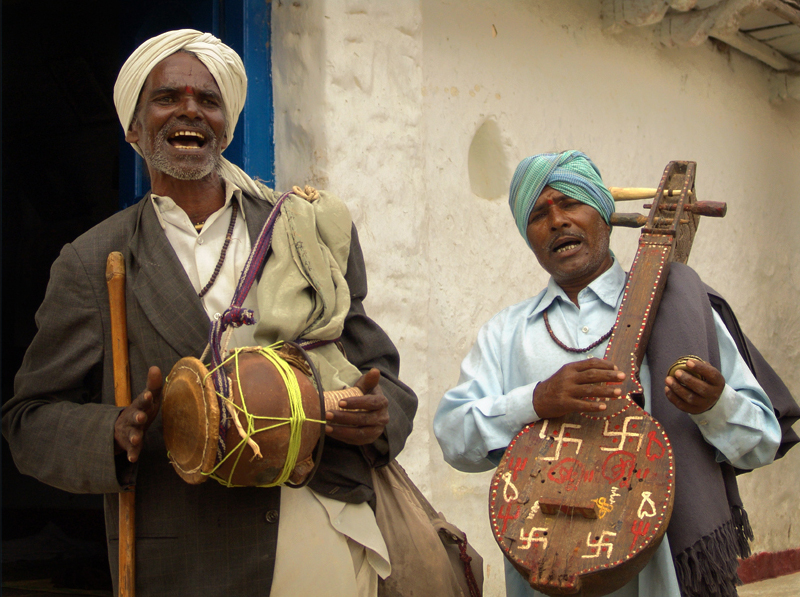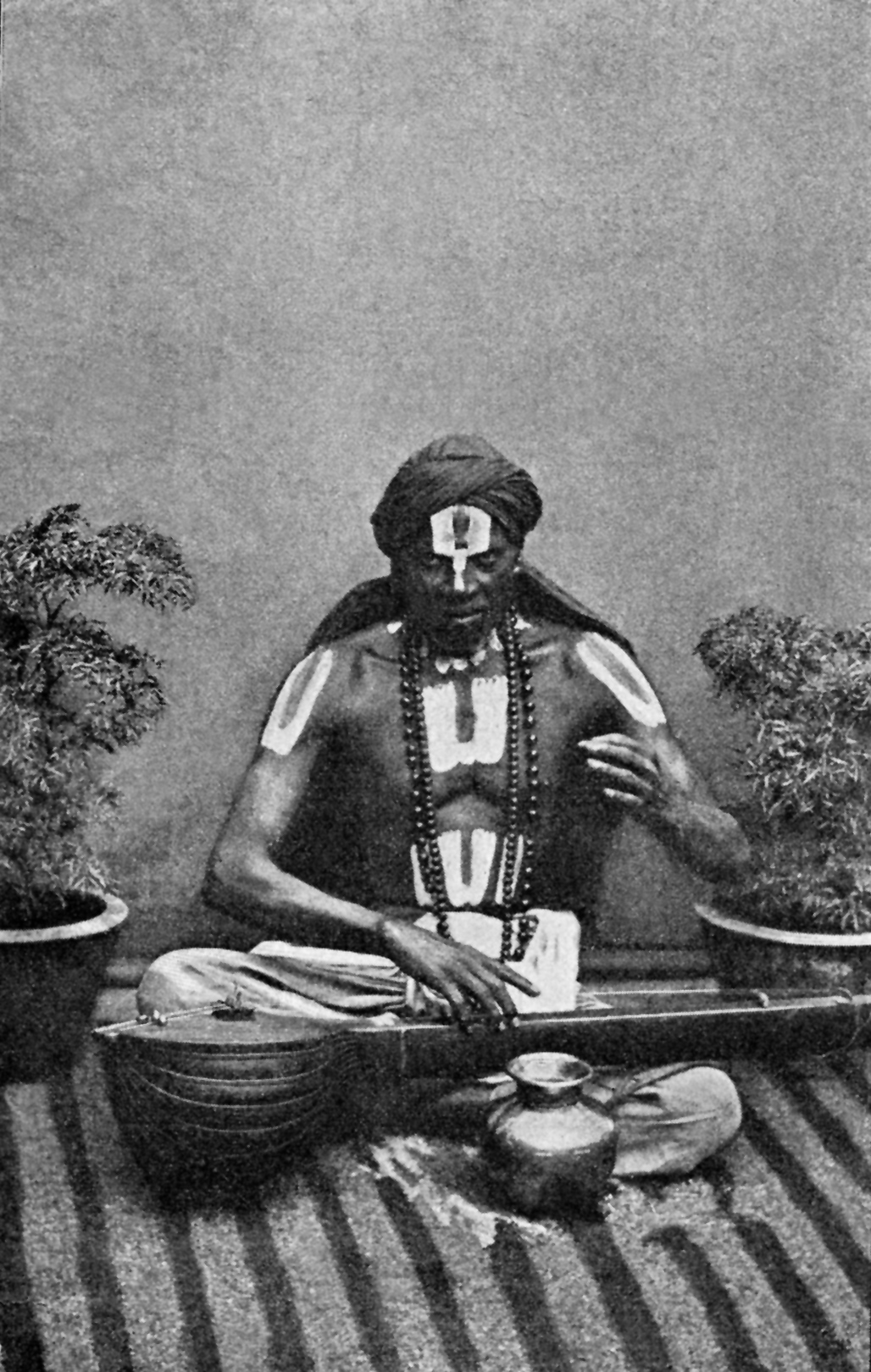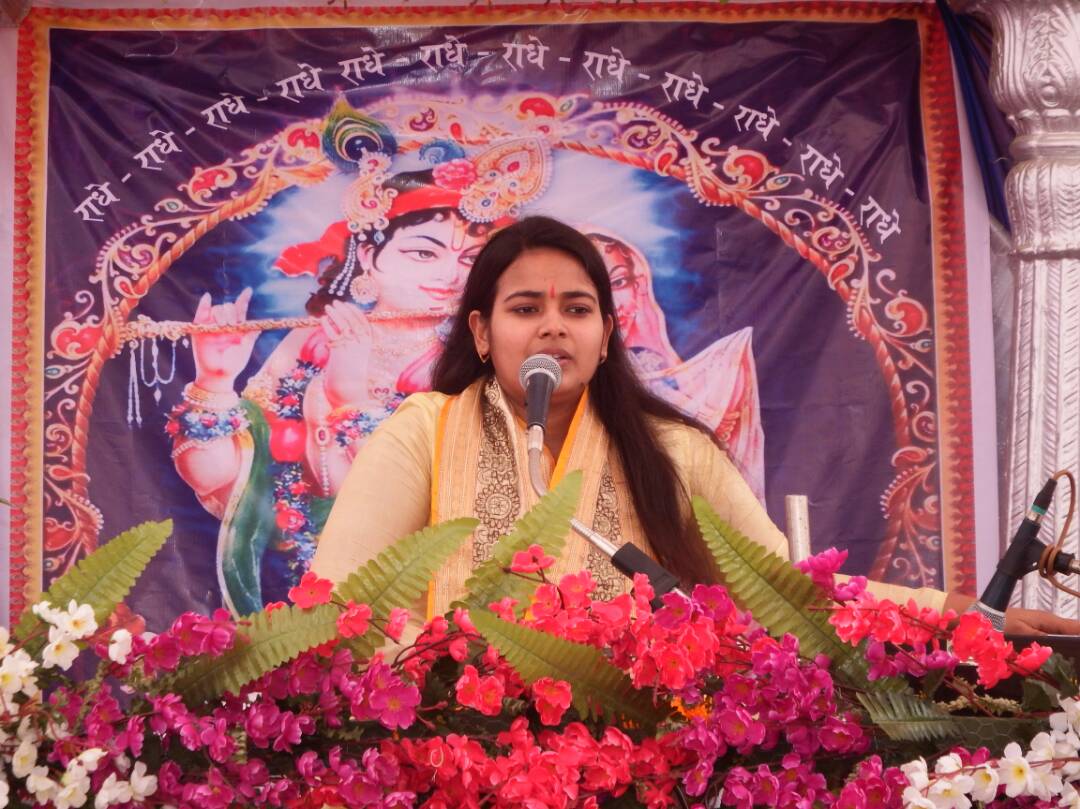|
Burrakatha
Burra Katha, also spelled Burrakatha, is an oral storytelling technique in the Jangam Katha tradition, performed in villages of Andhra Pradesh and Telangana. The troupe consists of one main performer and two co-performers. It is a narrative entertainment that consists of prayers, solo drama, dance, songs, poems and jokes. The topic will be either a Hindu mythological story ( Jangam Katha) or a contemporary social issue. It became popular art form during the Telangana Rebellion in the early 1930-1950. Origin The modern form of Burra Katha was developed in Guntur district around 1942 with the aim of propagating political ideas among illiterate masses in villages. Etymology "Burra" is referred to tambura, a musical string instrument with a hollow shell. "Katha" means story. Burra means brain in Telugu. The shell resembles a human skull. It is made of baked clay or dried pumpkin, or of brass and copper. The instrument looks very similar to veena and the performer can pull and p ... [...More Info...] [...Related Items...] OR: [Wikipedia] [Google] [Baidu] |
Burrakatha
Burra Katha, also spelled Burrakatha, is an oral storytelling technique in the Jangam Katha tradition, performed in villages of Andhra Pradesh and Telangana. The troupe consists of one main performer and two co-performers. It is a narrative entertainment that consists of prayers, solo drama, dance, songs, poems and jokes. The topic will be either a Hindu mythological story ( Jangam Katha) or a contemporary social issue. It became popular art form during the Telangana Rebellion in the early 1930-1950. Origin The modern form of Burra Katha was developed in Guntur district around 1942 with the aim of propagating political ideas among illiterate masses in villages. Etymology "Burra" is referred to tambura, a musical string instrument with a hollow shell. "Katha" means story. Burra means brain in Telugu. The shell resembles a human skull. It is made of baked clay or dried pumpkin, or of brass and copper. The instrument looks very similar to veena and the performer can pull and p ... [...More Info...] [...Related Items...] OR: [Wikipedia] [Google] [Baidu] |
Daroji Eramma
Daroji Eramma, popularly known as Burrakatha Eeramma, (1930–12 August 2014) was a folk singer and performer of the Burrakatha, a folk art form of epic storytelling from South India. She was awarded several awards including the Rajyotsava Prashasti in 1999. Life Eramma was born in 1930 in a family from the semi-nomadic Buduga Janagama community, a scheduled caste tribe. She learnt the Burrakatha from her father Lalappa as a young adolescent, and had taught this folk art form to the members of her family and community. Though illiterate, Eramma could perform twelve folk epics from memory, which amounts to 200,000 sentences and 7,000 pages in print. These folk epics include ''Kumararama'', ''Babbuli Nagireddi'', ''Baala Nagamma'', ''Jaisingaraaja Kavya'' and ''Bali Chakravarthi Kavya''. Her performances often lasted for days, accompanied by her sister, Shivamma, and her sister-in-law, Parvathamma on percussion, while Eramma herself would play a stringed instrument with one ha ... [...More Info...] [...Related Items...] OR: [Wikipedia] [Google] [Baidu] |
Andhra Pradesh
Andhra Pradesh (, abbr. AP) is a state in the south-eastern coastal region of India. It is the seventh-largest state by area covering an area of and tenth-most populous state with 49,386,799 inhabitants. It is bordered by Telangana to the north-west, Chhattisgarh to the north, Odisha to the north-east, Tamil Nadu to the south, Karnataka to the west and the Bay of Bengal to the east. It has the second longest coastline in India after Gujarat, of about . Andhra State was the first state to be formed on a linguistic basis in India on 1 October 1953. On 1 November 1956, Andhra State was merged with the Telugu-speaking areas (ten districts) of the Hyderabad State to form United Andhra Pradesh. ln 2014 these merged areas of Hyderabad State are bifurcated from United Andhra Pradesh to form new state Telangana . Present form of Andhra similar to Andhra state.but some mandalas like Bhadrachalam still with Telangana. Visakhapatnam, Guntur, Kurnool is People Capital of And ... [...More Info...] [...Related Items...] OR: [Wikipedia] [Google] [Baidu] |
India Village Musicians
India, officially the Republic of India (Hindi: ), is a country in South Asia. It is the seventh-largest country by area, the second-most populous country, and the most populous democracy in the world. Bounded by the Indian Ocean on the south, the Arabian Sea on the southwest, and the Bay of Bengal on the southeast, it shares land borders with Pakistan to the west; China, Nepal, and Bhutan to the north; and Bangladesh and Myanmar to the east. In the Indian Ocean, India is in the vicinity of Sri Lanka and the Maldives; its Andaman and Nicobar Islands share a maritime border with Thailand, Myanmar, and Indonesia. Modern humans arrived on the Indian subcontinent from Africa no later than 55,000 years ago., "Y-Chromosome and Mt-DNA data support the colonization of South Asia by modern humans originating in Africa. ... Coalescence dates for most non-European populations average to between 73–55 ka.", "Modern human beings—''Homo sapiens''—originated in Africa. Then, interm ... [...More Info...] [...Related Items...] OR: [Wikipedia] [Google] [Baidu] |
Ramayan
The ''Rāmāyana'' (; sa, रामायणम्, ) is a Sanskrit epic composed over a period of nearly a millennium, with scholars' estimates for the earliest stage of the text ranging from the 8th to 4th centuries BCE, and later stages extending up to the 3rd century CE. ''Ramayana'' is one of the two important epics of Hinduism, the other being the ''Mahābhārata''. The epic, traditionally ascribed to the Maharishi Valmiki, narrates the life of Sita, the Princess of Janakpur, and Rama, a legendary prince of Ayodhya city in the kingdom of Kosala. The epic follows his fourteen-year exile to the forest urged by his father King Dasharatha, on the request of Rama's stepmother Kaikeyi; his travels across forests in the Indian subcontinent with his wife Sita and brother Lakshmana, the kidnapping of Sita by Ravana – the king of Lanka, that resulted in war; and Rama's eventual return to Ayodhya to be crowned king amidst jubilation and celebration. The ''Ramayana'' is one of ... [...More Info...] [...Related Items...] OR: [Wikipedia] [Google] [Baidu] |
Hindu Traditions
Hindus (; ) are people who religiously adhere to Hinduism.Jeffery D. Long (2007), A Vision for Hinduism, IB Tauris, , pages 35–37 Historically, the term has also been used as a geographical, cultural, and later religious identifier for people living in the Indian subcontinent. The term ''"Hindu"'' traces back to Old Persian which derived these names from the Sanskrit name ''Sindhu'' (सिन्धु ), referring to the river Indus. The Greek cognates of the same terms are "''Indus''" (for the river) and "''India''" (for the land of the river). The term "''Hindu''" also implied a geographic, ethnic or cultural identifier for people living in the Indian subcontinent around or beyond the Sindhu (Indus) River. By the 16th century CE, the term began to refer to residents of the subcontinent who were not Turkic or Muslims. Hindoo is an archaic spelling variant, whose use today is considered derogatory. The historical development of Hindu self-identity within the local In ... [...More Info...] [...Related Items...] OR: [Wikipedia] [Google] [Baidu] |
Culture Of Andhra Pradesh
Culture () is an umbrella term which encompasses the social behavior, institutions, and norms found in human societies, as well as the knowledge, beliefs, arts, laws, customs, capabilities, and habits of the individuals in these groups.Tylor, Edward. (1871). Primitive Culture. Vol 1. New York: J.P. Putnam's Son Culture is often originated from or attributed to a specific region or location. Humans acquire culture through the learning processes of enculturation and socialization, which is shown by the diversity of cultures across societies. A cultural norm codifies acceptable conduct in society; it serves as a guideline for behavior, dress, language, and demeanor in a situation, which serves as a template for expectations in a social group. Accepting only a monoculture in a social group can bear risks, just as a single species can wither in the face of environmental change, for lack of functional responses to the change. Thus in military culture, valor is counted a typica ... [...More Info...] [...Related Items...] OR: [Wikipedia] [Google] [Baidu] |
Indian Styles Of Music
Indian or Indians may refer to: Peoples South Asia * Indian people, people of Indian nationality, or people who have an Indian ancestor ** Non-resident Indian, a citizen of India who has temporarily emigrated to another country * South Asian ethnic groups, referring to people of the Indian subcontinent, as well as the greater South Asia region prior to the 1947 partition of India * Anglo-Indians, people with mixed Indian and British ancestry, or people of British descent born or living in the Indian subcontinent * East Indians, a Christian community in India Europe * British Indians, British people of Indian origin The Americas * Indo-Canadians, Canadian people of Indian origin * Indian Americans, American people of Indian origin * Indigenous peoples of the Americas, the pre-Columbian inhabitants of the Americas and their descendants ** Plains Indians, the common name for the Native Americans who lived on the Great Plains of North America ** Native Americans in the Uni ... [...More Info...] [...Related Items...] OR: [Wikipedia] [Google] [Baidu] |
Hindu Music
Hindu music is music created for or influenced by Hinduism. It includes Indian classical music, Kirtan, Bhajan and other musical genres. Raagas are a common form of Hindu music in classical India. The most common Hindu bhajan in North India is " Om Jai Jagdish Hare." The names of Gods are religiously chanted, often including Vishnu and his incarnations, Shiva and the Goddess (Parvati, Shakti, Vaishnodevi). A very common scale in Hindu music is 1 2 3 4 5 6 7, which can be harmonized into a chord progression. ''Bhajan'' A bhajan is a Hindu devotional song, often of ancient origin. Bhajans are often simple songs in lyrical language expressing emotions of love for the Divine, whether for a single God and Goddess, or any number of divinities. Many bhajans feature several names and aspects of the chosen deity, especially in the case of Hindu sahasranamas, which list a divinity's 1008 names. Great importance is attributed to the singing of bhajans with Bhakti, i.e. loving devotion ... [...More Info...] [...Related Items...] OR: [Wikipedia] [Google] [Baidu] |
Drama
Drama is the specific mode of fiction represented in performance: a play, opera, mime, ballet, etc., performed in a theatre, or on radio or television.Elam (1980, 98). Considered as a genre of poetry in general, the dramatic mode has been contrasted with the epic and the lyrical modes ever since Aristotle's '' Poetics'' (c. 335 BC)—the earliest work of dramatic theory. The term "drama" comes from a Greek word meaning "deed" or " act" (Classical Greek: , ''drâma''), which is derived from "I do" (Classical Greek: , ''dráō''). The two masks associated with drama represent the traditional generic division between comedy and tragedy. In English (as was the analogous case in many other European languages), the word ''play'' or ''game'' (translating the Anglo-Saxon ''pleġan'' or Latin ''ludus'') was the standard term for dramas until William Shakespeare's time—just as its creator was a ''play-maker'' rather than a ''dramatist'' and the building was a ''play-house'' r ... [...More Info...] [...Related Items...] OR: [Wikipedia] [Google] [Baidu] |
Pravachan
Pravachan, or Pravacana () is a term for any exposition of a doctrine or treatise, or to the recitation of a scripture or text in Jainism and Hinduism traditions.Monier Monier WilliamsSanskrit English Dictionary with Etymology Oxford University Press, page 690 It particularly refers to the tradition of ''Pravacanakara'' (monks, scholars or saints) presenting their teachings or explanations of spiritual ideas before a gathering of householders or general public in the Indian traditions. ''Pravacana'' is an ancient tradition, whose earliest mentions are found in the Vedic texts but one that is also found in post-Vedic Shastra and Sutra texts of Hindus and Jains. Buddhism ''Pravacana'' refers to ninefold dhamma in Buddhist texts, and its recitation. It was adopted from the Vedic tradition, and sometimes referred to as Pavachan. Hinduism ''Pravacana'' (Sanskrit: प्रवचन) refers to "exposition, expounding, reciting, orally explaining, speaking or talking" about a spiri ... [...More Info...] [...Related Items...] OR: [Wikipedia] [Google] [Baidu] |
Oggu Katha
Oggu Katha or Oggukatha is a traditional folklore singing, praising and narrating the stories of Hindu gods Mallana, Beerappa and Yellamma. It originated among the Kuruma ( Kuruba)and Yadava communities, who devoted themselves to the singing of ballads in praise of Lord Shiva (also called Mallikarjuna). These tradition-loving and ritual-performing community moves from place to place, narrating the stories of their caste gods. Oggus are the traditional priests of the Yadavas and perform the marriage of Mallanna with Bhramaramba. The story narrated about Lord Mallanna or Mallikarjuna Swamy using the instrument "Jaggu"(damarukam) is known as Oggu Katha. Used at the beginning of each story and also at the marriage festival of Lord Mallanna. Founder of Oggu kathalu was Sri. Vallam Pedda Veeraiah which was continued by his son Vishwa Vikyatha Oggu Katha Sarva Bhoumulu Vallam Sathaiah. The stories, scripts, dialogues and lyrics on Kommaravelli Mallana, Yellama Devi, Nalla Pochamma D ... [...More Info...] [...Related Items...] OR: [Wikipedia] [Google] [Baidu] |



.jpg)



